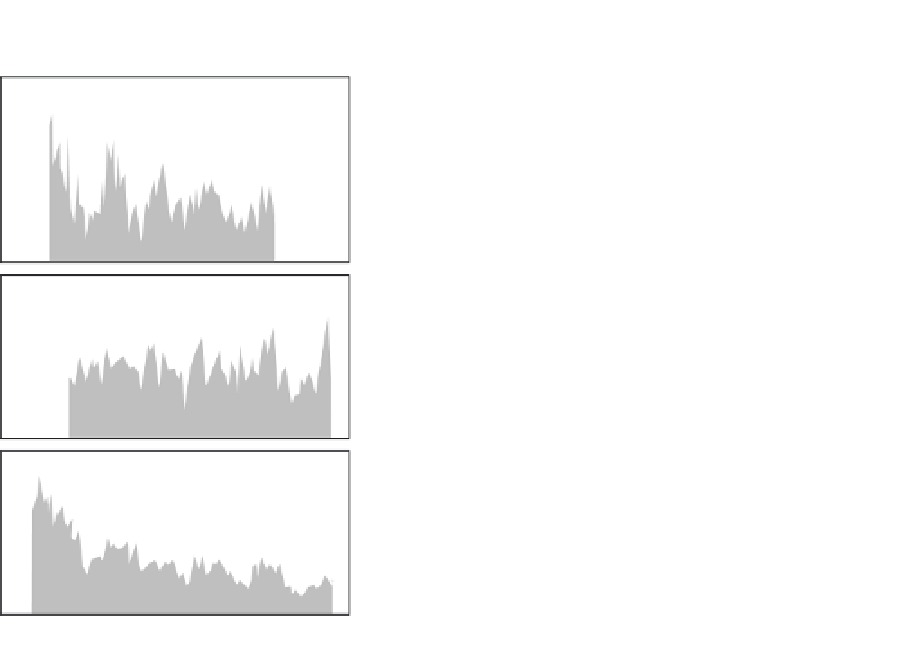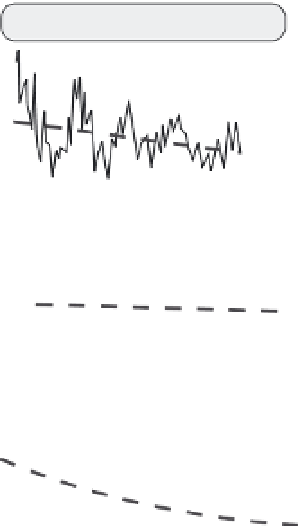Geology Reference
In-Depth Information
list a few of the commonly used radioactive
isotopes, their decay constants, and their
associated half-lives. We will see that in some
cases it is either more instructive or easier to
measure the accumulation of the daughter
isotopes, or the ratio of the parent to the daughter,
rather than the parent.
Douglas Fir Tree Rings
4
Tree 4
3
2
1
4
3
2
1
0
Tree 1
Tree rings
An entire science of dendrochronology has
evolved around the dating of geomorphic
surfaces using tree rings and the exploration of
climatic change using the tree-ring width as a
surrogate for climatic stresses. In climates with
a distinct growing season, trees put on new
wood in discrete layers that may be counted to
reveal the age of the tree. Growth is rapid in the
wet season and the summer, then slows in the
winter, resulting in relatively low-density wood
with large cells in the growth season, separated
by layers of denser, finer wood. Whereas the
easiest application is obviously to date a surface
with the trees still growing (by cutting down the
tree or by coring the tree with a boring device),
the technique has been augmented greatly by
extending the time series derived from living
trees through the addition of time series from
dead trees. Tree-ring thickness and the density
of the wood in the rings are documented using
any of several methods, including X-ray images
and now even blue-light intensity (e.g., Campbell
et al.
, 2007). As the thickness or width of the
annual growth ring is dictated by the climatic
conditions of water availability and temperature,
tree-ring width time series can be viewed as a
proxy for a climatic time series. That this climate
time series reflects at least a regional, if not a
global, phenomenon means that trees far
separated should record the same temporal
pattern of ring widths. We note that one must
take care to account both for the species of the
tree and for the long-term trend (decrease) in
the rate of ring growth through time as any tree
matures (Fig. 3.8). A ring-matching technique
is, therefore, based on a master tree-ring
time series that is compiled from a set of trees
whose ring-width series overlap. For example,
5
4
3
2
1
0
Tree 2
1800
1900
2000
Calendar Year
Fig. 3.8
Tree-ring widths in Douglas firs as a function
of time in the Pacific Northwest of the United States.
The tree-ring width shows decline in growth rate with
age, best seen in Tree 2 (dashed line). Superposed on
this trend are the modulations in growth rate associated
with variations of local climate. Modified after
Yamaguchi and Hoblitt (1995).
Yamaguchi and Hoblitt (1995) demonstrated the
time of burial of trees on Mount St. Helens by
debris from prehistoric volcanic eruptions by
matching the ring-width time series from trees
embedded in or buried by lahars with that
of the master tree-ring chronology. This
methodology entailed choosing a date for the
volcanic event (= the age of the outermost ring),
calculating the correlation coefficient between
the sample tree-ring width series and that of the
master tree-ring series, choosing another sample
age, recalculating the correlation, and so on.
The resulting plot of correlation versus
outermost ring age reveals a strong spike in a
particular year, which is interpreted to be the
correct match (Fig. 3.9). The technique relies
strongly on a trustworthy master tree-ring time
series and works best for dating large trees with




















































